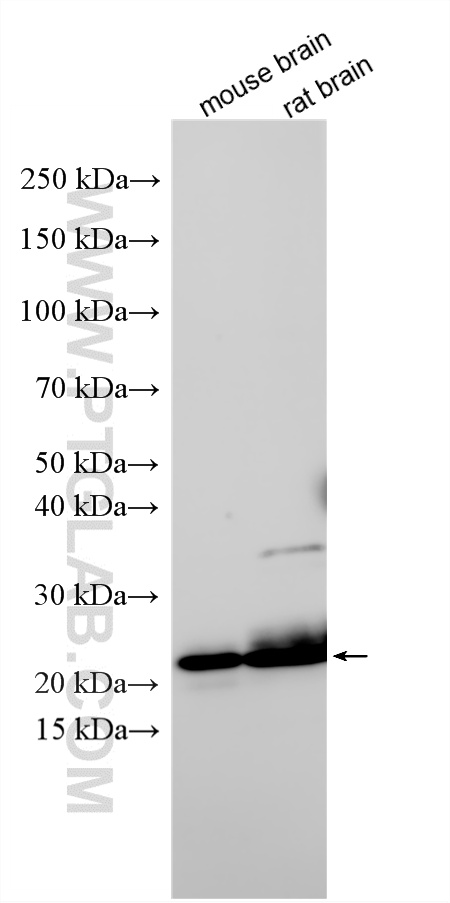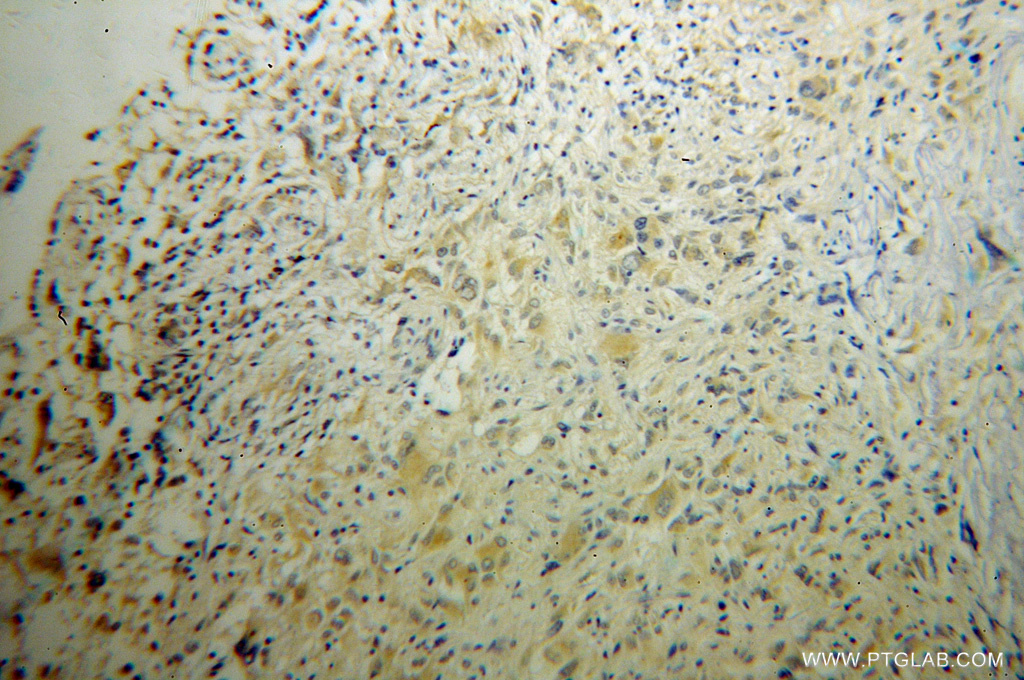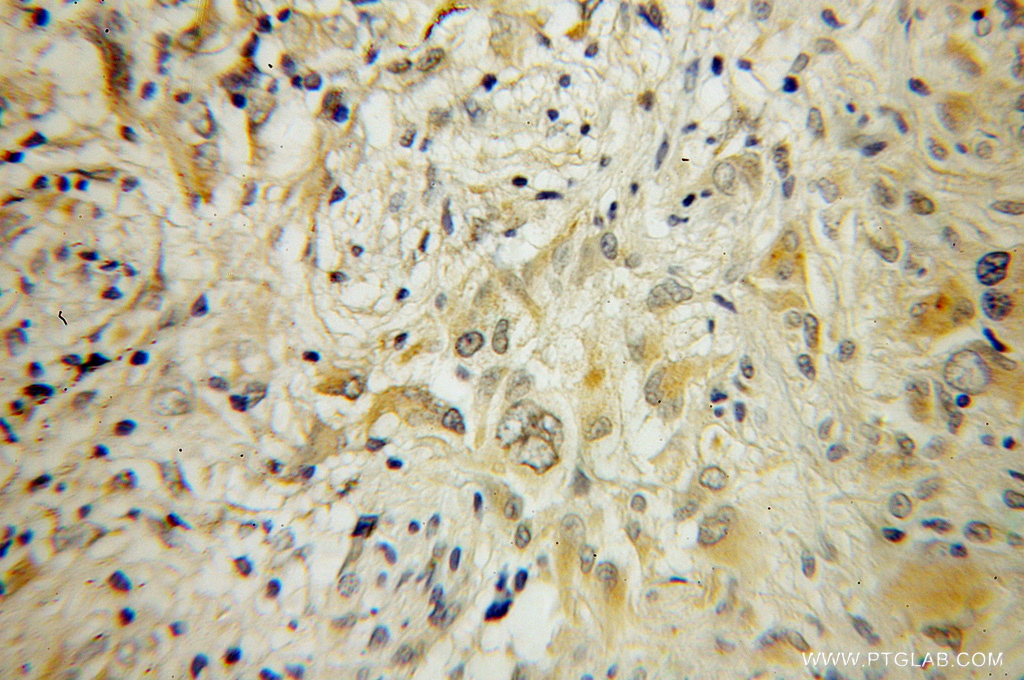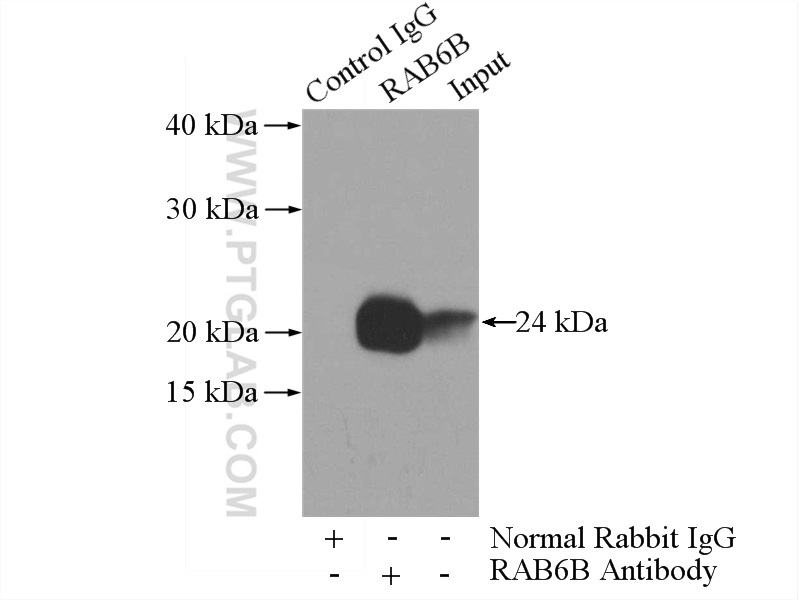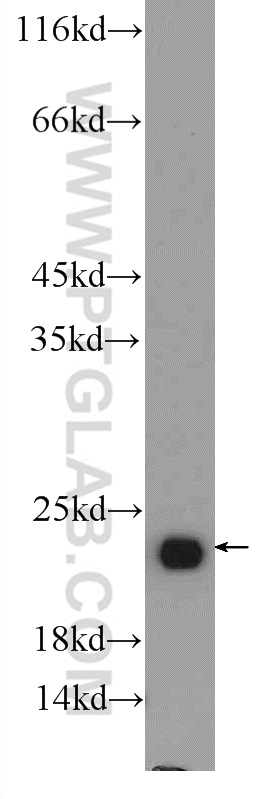验证数据展示
经过测试的应用
| Positive WB detected in | mouse brain tissue, C6 cells, rat brain tissue |
| Positive IP detected in | mouse brain tissue |
| Positive IHC detected in | human gliomas tissue Note: suggested antigen retrieval with TE buffer pH 9.0; (*) Alternatively, antigen retrieval may be performed with citrate buffer pH 6.0 |
| Positive IF/ICC detected in | C6 cells |
推荐稀释比
| 应用 | 推荐稀释比 |
|---|---|
| Western Blot (WB) | WB : 1:1000-1:4000 |
| Immunoprecipitation (IP) | IP : 0.5-4.0 ug for 1.0-3.0 mg of total protein lysate |
| Immunohistochemistry (IHC) | IHC : 1:20-1:200 |
| Immunofluorescence (IF)/ICC | IF/ICC : 1:200-1:800 |
| It is recommended that this reagent should be titrated in each testing system to obtain optimal results. | |
| Sample-dependent, Check data in validation data gallery. | |
产品信息
10340-1-AP targets RAB6B in WB, IHC, IF/ICC, IP, ELISA applications and shows reactivity with human, mouse, rat samples.
| 经测试应用 | WB, IHC, IF/ICC, IP, ELISA Application Description |
| 文献引用应用 | WB, IF |
| 经测试反应性 | human, mouse, rat |
| 文献引用反应性 | human, mouse, rat |
| 免疫原 |
CatNo: Ag0322 Product name: Recombinant human RAB6B protein Source: e coli.-derived, PGEX-4T Tag: GST Domain: 25-208 aa of BC002510 Sequence: GKTSLITRFMYDSFDNTYQATIGIDFLSKTMYLEDRTVRLQLWDTAGQERFRSLIPSYIRDSTVAVVVYDITNLNSFQQTSKWIDDVRTERGSDVIIMLVGNKTDLADKRQITIEEGEQRAKELSVMFIETSAKTGYNVKQLFRRVASALPGMENVQEKSKEGMIDIKLDKPQEPPASEGGCSC 种属同源性预测 |
| 宿主/亚型 | Rabbit / IgG |
| 抗体类别 | Polyclonal |
| 产品类型 | Antibody |
| 全称 | RAB6B, member RAS oncogene family |
| 别名 | EC:3.6.5.2, Ras related protein Rab 6B, Ras-related protein Rab-6B |
| 计算分子量 | 23 kDa |
| 观测分子量 | 24 kDa |
| GenBank蛋白编号 | BC002510 |
| 基因名称 | RAB6B |
| Gene ID (NCBI) | 51560 |
| RRID | AB_2175461 |
| 偶联类型 | Unconjugated |
| 形式 | Liquid |
| 纯化方式 | Antigen affinity purification |
| UNIPROT ID | Q9NRW1 |
| 储存缓冲液 | PBS with 0.02% sodium azide and 50% glycerol, pH 7.3. |
| 储存条件 | Store at -20°C. Stable for one year after shipment. Aliquoting is unnecessary for -20oC storage. |
背景介绍
The human RAB genes share structural and biochemical properties with the Ras gene superfamily. Accumulating data suggests an important role for RAB proteins either in endocytosis or in biosynthetic protein transport. The transport of newly synthesized proteins from endoplasmic reticulum to the Golgi complex and to secretory vesicles involves the movement of carrier vesicles, a process that appears to involve RAB protein function. Rab6A has been shown to be a regulator of membrane traffic from the Golgi apparatus towards the endoplasmic reticulum (ER). Rab6B is encoded by an independent gene which is located on chromosome 3 region q21-q23. In contrast to Rab6A whose expression is ubiquitous, Rab6B is expressed in a tissue and cell-type specific manner. Rab6B is predominantly expressed in brain and the neuroblastoma cells. In brain, Rab6B was found to be specifically expressed in microglia, pericytes and Purkinje cells. Endogenous Rab6B localises to the Golgi apparatus and to ERGIC-53-positive vesicles. Comparable studies between Rab6A and Rab6B revealed distinct biochemical and cellular properties. Rab6B displays lower GTP-binding activities and is distributed over Golgi and ER membranes, whereas Rab6A is more restricted to the Golgi apparatus. Since the GTP-bound form of Rab6B does interact with all known Rab6A effectors, including Rabkinesin-6, the results suggest a cell-type specific role for Rab6B in retrograde membrane traffic at the level of the Golgi complex.
实验方案
| Product Specific Protocols | |
|---|---|
| IF protocol for RAB6B antibody 10340-1-AP | Download protocol |
| IHC protocol for RAB6B antibody 10340-1-AP | Download protocol |
| IP protocol for RAB6B antibody 10340-1-AP | Download protocol |
| WB protocol for RAB6B antibody 10340-1-AP | Download protocol |
| Standard Protocols | |
|---|---|
| Click here to view our Standard Protocols |
发表文章
| Species | Application | Title |
|---|---|---|
Life Sci Sex-specific molecular hallmarks point to increased atherogenesis susceptibility in male senescence-accelerated mice | ||
J Neuroimmunol Autoantibody against the Rab6A/Rab6B in primary autoimmune cerebellar ataxia associated with Sjogren's syndrome: A case report. | ||
EMBO Rep RAB6 and dynein drive post-Golgi apical transport to prevent neuronal progenitor delamination
| ||
Mol Biol Cell Movement of the endoplasmic reticulum is driven by multiple classes of vesicles marked by Rab-GTPases
|

